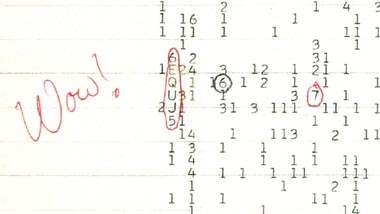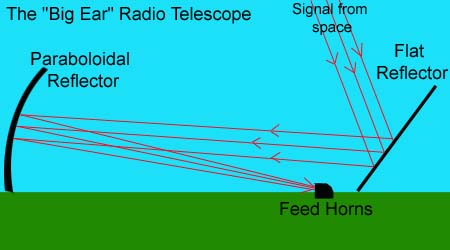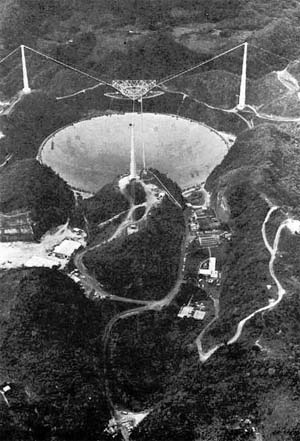pop up description layer
HOME
Cryptozoology UFO Mysteries Aviation Space & Time Dinosaurs Geology Archaeology Exploration 7 Wonders Surprising Science Troubled History Library Laboratory Attic Theater Store Index/Site Map Cyclorama
Search the Site: |
|
The
"WOW!" Signal On August 19, 1977, Jerry R. Ehman, a professor at Ohio State University, was sitting at his kitchen table when he realized that he may have been the first human to have been contacted by an extra-terrestrial, alien race. The story behind Ehman's revelation started in 1961 when Frank Drake, a Cornell University astronomer, was looking for a way to stimulate thinking at an upcoming scientific conference on intelligent life in outer space. He began to ponder the mathematics of the problem wondering what the chances were of contacting other intelligent beings out in space via radio. The result was the now famous "Drake Equation." Drake Equation N = G P E L I C Y The equation, in theory, estimates the number of alien civilizations in our galaxy that might produce radio transmissions we can detect. The G in the formula is the number of stars in our galaxy, P is the fraction of stars that have planets, E is the fraction of planets around a star that can sustain life, L is the fraction of those planets that actually develop life, I is the fraction that develop intelligent life, C is the fraction of those that build civilizations that can communicate and Y is the number of years that the civilization survives. From the beginning the formula was controversial since so many of the figures that go into the equation are unknown and their values could vary wildly. For example, if the fraction of worlds on which life develops is sufficiently close to zero, because it is multiplied against all the other elements, it could make the number of alien civilizations very small no matter how large the values all the other variables carry. Even so, the Drake Equation seemed to suggest that there would be a number of civilizations in our galaxy that might be broadcasting radio signals, so the Search for Extra-Terrestrial Intelligence (SETI), which Drake had founded the year before, started to expand. SETI Searches In 1960 Drake had done his initial research using a 26-meter radio telescope dish at Green Bank, West Virginia. He pointed the telescope towards the stars Tau Ceti and Epsilon Eridani and looked for any broadcast signals near the 1.420 gigahertz radio frequency. Drake thought it likely that any alien civilization trying to make its presence known would broadcast a signal near that frequency because the hydrogen spectral line was located there and hydrogen was the most abundant element in the universe.
Drake failed to find any interesting signals, but other scientists thought that the search was worthwhile and started projects to scan the skies. In the 60's scientists from the Soviet Union became interested in SETI and conducted several searches. Back in the United States, Ohio University had constructed a radio telescope called the "Big Ear" in 1963. The device had been used for several scientific research projects, including a study of the Andromeda Galaxy. In 1973, however, Bob Dixon, on staff at Ohio, realized that idle time on the telescope might be used for SETI research and organized some volunteers to help. The program ran from 1975 to 1983. The "Big Ear" was unlikeradio telescopes that most people might picture in their mind. It wasn't shaped like a big dish as the one at Green Bank that Drake had used. A dish like that could be pointed to any location in the sky. Instead the "Big Ear" was composed of a flat signal reflector 340 feet wide and 100 feet high. This flat reflector could be tilted up and down 50 degrees to point at almost any vertical (up and down) location above the horizon. The radio waves coming from the sky would bounce off the flat reflector and over to a parabolic reflector 360 feet wide and 70 feet high that was 500 feet away. The parabolic reflector would then concentrate the signal to a location on the ground just in front of the flat reflector where two "horns" were located. The horns would further concentrate the signal and pass it to a receiver where it would be converted to electrical impulses. These would then be analyzed by a computer. The weakness of the "Big Ear" was that though it could be pointed to a wide area of the sky up and down, it could not be swung left or right. In order to observe those areas, it had to wait until that section of the sky was brought in front of it by the rotation of the earth. Then it could observe that location for up to 72 seconds. The strength of the "Big Ear" was that even though it could not be pointed in arbitrary directions because of its enormous size, it was sensitive to very weak signals. The Signal Two years into the "Big Ear's" SETI program came the incident that still puzzles scientists to this day. On August 15, 1977, at 10:16 PM EST, a computer running the SETI program that controlled the telescope recorded a signal coming from space. Nobody was at the telescope at the time and the computer, as it always did recorded the characteristics of the signal automatically. Later information about the signal was printed onto a paper listing so it (along with everything else recorded by the computer) could be reviewed by a human being. Now, getting a radio signal from a source in space wasn't that strange at all. That's what the "Big Ear" was built for. Most sources are from natural celestial objects including pulsars (rapidly rotating burned out stars) or quasars (distant, bright galaxies). What made this signal different and caught the attention of Jerry Ehman, when he reviewed the printout several days later, was the shape and the strength. Most natural signal sources come in a very wide band involving many adjacent radio frequencies. Artificial, man-made sources, however, are almost always narrow-band involving just a few frequencies.
One common misconception is that "Wow!" was the content of the signal, but it was only Ehman's reaction to it. Another is that the content of the signal was the number/letters Ehman circled on the paper. Those are only the way the computer represented the strength of the signal. The content of it, if there was any, was not recorded by the computer and is unknown. Possible Causes Investigated Ehman and others have searched for explanations of the signal beyond an intelligent, extra-terrestrial source, but so far nothing seems to fit the bill. One early thought was that it was a terrestrial radio signal bouncing off a piece of space junk. However, the frequency that the signal came in on was approximately 1420 MHz., very near the frequency emitted by hydrogen atoms. This frequency is reserved for astronomical observations and no transmitter on Earth should be using it. Also, the signal's expected characteristics, if it had been bounced off a piece of space junk in Earth's orbit, did not completely match that of the "WOW" signal. A piece of space junk in low orbit would be moving, changing the length of the signal. It would also be tumbling, which would change the amplitude of the signal so it did not grow and fall in a nice, smooth curve.
Other possibilities of the source of the signal that have been eliminated were satellites, airplanes and spacecraft. No known satellite or spacecraft was in the right position and none should have been transmitting near 1420 MHz. Airplanes would have been moving and would have changed the observation time, and again, none should have been transmitting at 1420 MHz. The area that the "Big Ear" was pointing at when it detected the "Wow!" signal was northwest of the globular cluster M55. There are no close stars in that area that might seem to be the source of an extra-terrestrial signal. The "Big Ear" listened for a return of the signal on subsequent occasions, but it was never heard again. In fact the "Big Ear" had two horns which swept the sky that day about 5 minutes apart.The signal was heard by only one of the horns, not both, so it seems that the signal was either switched off or directed to a different location during those five minutes. Many radio telescopes have listened for a signal in that location since then, but have found nothing. What does this mean? Scientists connected with the project think that even though it looked like an alien signal, without being able to detect it again and study it, there is no way to ever know for sure. Ehman himself cautions against making "vast conclusions from 'half-vast' data. So the "Wow!" signal remains a true modern mystery. Was ET trying to talk to us and if he was, will he phone again? Copyright Lee Krystek 2015. All Rights Reserved. |
|
Related Links |
|
|





 The
signal that Ehman noticed was very narrow and strong. What's more,
it lasted almost exactly 72 seconds. This was significant as that
was the amount of time the "Big Ear" was able to detect a signal
from deep space as its observation zone swept the sky. The way
the signal started, became strong, and then dropped away over
that period was exactly what would be expected from a deep space
signal heard by the "Big Ear." Ehman was so impressed by the signal
being exactly what was expected of an alien contact that he circled
it on the paper and wrote the word "Wow!" next to it in red ink.
The incident has been known as the "Wow!" signal ever since.
The
signal that Ehman noticed was very narrow and strong. What's more,
it lasted almost exactly 72 seconds. This was significant as that
was the amount of time the "Big Ear" was able to detect a signal
from deep space as its observation zone swept the sky. The way
the signal started, became strong, and then dropped away over
that period was exactly what would be expected from a deep space
signal heard by the "Big Ear." Ehman was so impressed by the signal
being exactly what was expected of an alien contact that he circled
it on the paper and wrote the word "Wow!" next to it in red ink.
The incident has been known as the "Wow!" signal ever since.
